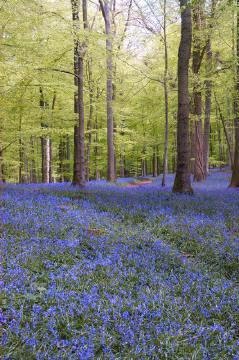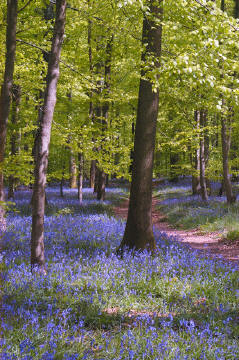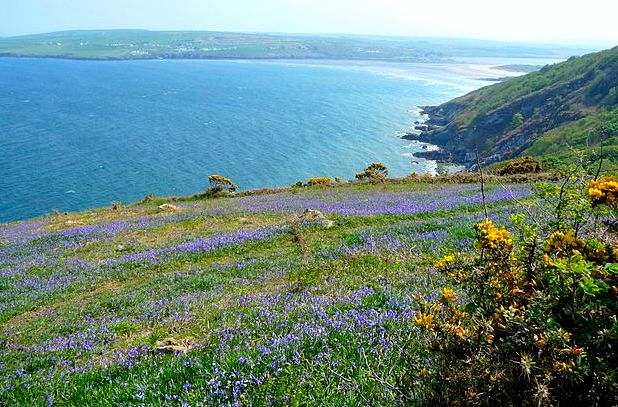|
Article
Where to
Photograph Bluebells in the UK
Whenever Britain runs a
'Favourite Flower survey', Bluebells rate very highly on the list, which is
quite appropriate as Britain is said to contain more than half the worlds population of
Bluebells. They usually flower in April and May each year depending on their
location and the weather conditions.
Within the UK countryside some feel that
the native British Bluebell is at risk, due to a number of factors but including the
destruction of it's native woodland habitat for agriculture or being converted
to coniferous woodland, but also the threat of interbreeding with the Spanish
bluebells which were introduced into British garden's in the 17th century and
since the 20th century have escaped into the British countryside. This has
resulted in one in six bluebells seen in our woodlands today being a mixture of
British, Spanish and a hybrid of the two.
What to look out for:
-
Native Bluebells will be found in,
but not restricted to, woodland and they are perfectly adapted to cope with the
shade created by the woodland canopy.
-
The first
green shoots emerge in
January as they push their way through the surface of the woodland floor, with
them flowering around April-May each year depending on their location
and the local climate.
-
The number and density of the
flowers give the impression of a carpet of blue on the woodland floor.
-
The deep blue-violet flowers
are narrow, with parallel sides and give off a sweet scent.
-
The bells are positioned at
the top of the stem and almost entirely on one side which causes them to droop
to one side.
-
The leaves are fairly narrow,
between 6-20mm wide halfway down the leaf.
-
The further west in Britain
you go the more widespread they become in other habitats such as grassland,
heath, scrub, sea cliffs and hedge banks.
-
The highest recorded
sightings of bluebells within the UK has been on
Craig-yr-Ysfa
 in Snowdonia at
685m up. in Snowdonia at
685m up.
|
  |
|
Facts and
Folklore
There
is archaeological evidence that Bronze Age people used bluebell glue to attach
feathers to their arrows.
Bluebell sap was used to bind pages into the spines of books.
Bluebell bulbs were crushed to provide starch for the ruffs of Elizabethan
collars and sleeves.
Like a
lot of things in Britain they have their own claim to folklore, with Bluebell
Woods and fairies. It is said that the magical creations of fairies were summoned
by the ringing of the bluebells, and anyone who heard the flowers chime would
not have long to live.
They
are important early flowers for bees, hoverflies and butterflies which feed on
the nectar.
Bees
can 'steal' the nectar from the flowers by biting a hole in the bottom of the
bell, reaching the nectar without pollinating the flower.
|
  |
Bluebell Survey
In
recent years the Natural History Museum ran an annual survey of bluebell
populations within the UK. Members of the public were asked to help search for
bluebells, in their area or when out and about to help them identify where they
are. They built a picture of the distribution of British Bluebells and when and
where they first flower across the country.
Photographing Bluebells
The blue colour of the
bluebell is a challenge to photograph, just like purple. It is achievable if
done correctly, and when out on location photographing bluebells an essential tool is
your
white balance target,
 whether that be a piece of grey card or one of the
many manufactured targets you can purchase today such as the
Lastolite
EzyBalance. whether that be a piece of grey card or one of the
many manufactured targets you can purchase today such as the
Lastolite
EzyBalance.

Before taking your picture take time to set up the
White Balance
 (WB) using your camera's
PRE
(WB) using your camera's
PRE
 for the different lighting conditions you come
across, they are not going to move on and you will be more than pleased with
your results when you return to your computer with the limited amount of
editing you will need to do. We have a range of articles specifically on white
balance and colour management, see links below. for the different lighting conditions you come
across, they are not going to move on and you will be more than pleased with
your results when you return to your computer with the limited amount of
editing you will need to do. We have a range of articles specifically on white
balance and colour management, see links below.
The best type of day is a
bright still one, so that the heads stay still, and not too much sunshine will give the
blues a much deeper colour. Bluebells are found predominantly in woodlands, but
can also be found at other locations such as grassland, heath, scrub, sea cliffs
and hedge banks.
By their very nature
woodlands
 tend to be dark especially once the leaves are on the trees, so from this
perspective if you can, you need to visit before the trees are totally covered
in leaves. This can be difficult to judge and it might be that you need to visit
your preferred spot a number of times until you get the right conditions to
capture them. If you happen to come across a carpet of them at the coast, whilst
out
walking
tend to be dark especially once the leaves are on the trees, so from this
perspective if you can, you need to visit before the trees are totally covered
in leaves. This can be difficult to judge and it might be that you need to visit
your preferred spot a number of times until you get the right conditions to
capture them. If you happen to come across a carpet of them at the coast, whilst
out
walking
 then the sun is likely to be your biggest problem, so position yourself to cut
down the most sun you can, and make sure you have used the
PRE
then the sun is likely to be your biggest problem, so position yourself to cut
down the most sun you can, and make sure you have used the
PRE
 setting on your camera so that you capture the colours correctly at source and
then you can always boost the colours in editing afterwards. If you're trying to
do a
macro
setting on your camera so that you capture the colours correctly at source and
then you can always boost the colours in editing afterwards. If you're trying to
do a
macro
 shot then try using something or someone, if you're not on your own, to block
out some of the direct sunlight, but watch out for shadows, this can alter the
colours and it will be necessary to do another
PRE
shot then try using something or someone, if you're not on your own, to block
out some of the direct sunlight, but watch out for shadows, this can alter the
colours and it will be necessary to do another
PRE
 setting.
setting.

Cemaes Head on the
Pembrokeshire Coast Path
 Jeremy
Bolwell
Jeremy
Bolwell

Finding Bluebell locations
Bluebells can be found in
very many
woodlands
 throughout Britain and driving around many areas like
the Cotswolds, Forest of Dean, and many others, as well as taking woodland
walks throughout Britain and driving around many areas like
the Cotswolds, Forest of Dean, and many others, as well as taking woodland
walks
 you are going to come across them at the right time.
you are going to come across them at the right time.
There are some places
which have become particularly well known, such as
Micheldever Woods
 in Hampshire, and my favourite location is in the
Forest of Dean
in Hampshire, and my favourite location is in the
Forest of Dean
 in Gloucestershire, at Staple Edge Wood in the Soudley Valley.
in Gloucestershire, at Staple Edge Wood in the Soudley Valley.
To find a location a bit more local to you you may find our
Bluebell Locations lists
of help, which lists some of the more well known sites we have been able to
identify. If you know of any that we have not included then please let us know
and we will add them for everybody else to share.
Where to Photograph Bluebells in England

Where to Photograph Bluebells in Scotland

Where to Photograph Bluebells in Wales

Where to Photograph Bluebells in Northern Ireland

The following is a list of articles specifically on white balance,
colour management
 and how to set PRE. Take a look you may find some interesting
techniques and methods you could use to help get that bluebell photograph with
impact. and how to set PRE. Take a look you may find some interesting
techniques and methods you could use to help get that bluebell photograph with
impact.
So what is white balance
and why won’t auto white balance do
 Here we look at what white
balance is and why we should use it, introducing the topic and giving the
foundations for other articles. Here we look at what white
balance is and why we should use it, introducing the topic and giving the
foundations for other articles.
Setting and using PRE
 The PRE setting within white balance allows us to
get the most accurate colours and here we look at this in detail and how to
use it. The PRE setting within white balance allows us to
get the most accurate colours and here we look at this in detail and how to
use it.
Colour management
outlined
 explains briefly the
larger topic of colour management, although concentrating on the aspects that
are connected with white balance. explains briefly the
larger topic of colour management, although concentrating on the aspects that
are connected with white balance.
Choosing the white balance setting to use
 looks at how to use the camera settings in
relation to white balance on a Nikon DSLR. If you have another make of
camera you will still have similar controls.
looks at how to use the camera settings in
relation to white balance on a Nikon DSLR. If you have another make of
camera you will still have similar controls.
Other steps we can
take on white balance  There are other ways to manage colour and other
approaches, and this article covers some of these.
There are other ways to manage colour and other
approaches, and this article covers some of these.
The K values of
light  is a table
rather than an article and gives the colours of different types of light.
is a table
rather than an article and gives the colours of different types of light.
Exposure and White Balance Targets

You may also find the
following of help:
Exposure

Filters Section

See Also:-
visitwoods.org.uk
 The Woodland Trusts special Woodland Website that incorporates the woods owned
and managed by itself, but also those of the Forestry Commission, Wildlife
Trusts, RSPB and the National Trust.
The Woodland Trusts special Woodland Website that incorporates the woods owned
and managed by itself, but also those of the Forestry Commission, Wildlife
Trusts, RSPB and the National Trust.
Natures Calendar Survey
 A site also managed by the Woodland Trust,
but looks more at the wildlife and nature in the UK.
Is the home for volunteers to record the signs of
the seasons where they live, and it is open to anyone to take part. There are
links to a free downloadable nature identification booklet as well as
other free wildlife guides, forms for recording as well as a link to submit your
findings. This particular link goes to their Bluebell Fact page.
A site also managed by the Woodland Trust,
but looks more at the wildlife and nature in the UK.
Is the home for volunteers to record the signs of
the seasons where they live, and it is open to anyone to take part. There are
links to a free downloadable nature identification booklet as well as
other free wildlife guides, forms for recording as well as a link to submit your
findings. This particular link goes to their Bluebell Fact page. |